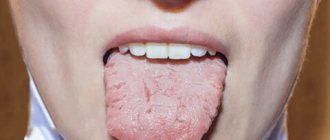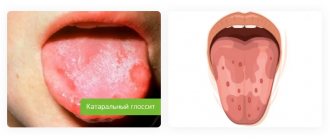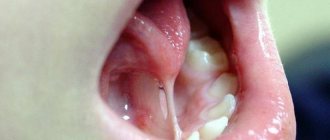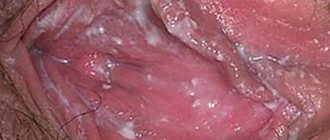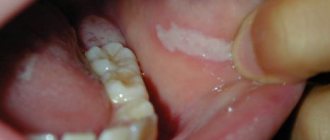Glossitis is an inflammatory disease of the tongue, which can act as an independent pathology or be a symptom of other diseases of the internal organs. Sometimes a change in the shape or color of the tongue may be the only sign indicating a problem in the body. Therefore, it is important not to ignore painful changes in the oral cavity.
Self-medication can lead to chronic glossitis, which is characterized by severe growths and the appearance of ulcers. Seeing a doctor will help you make a correct diagnosis and cope with the disease in a short time.
Causes of glossitis
Glossitis can be an independent disease caused by bacteria, or a sign of a certain systemic pathology. Microtraumas and viruses usually lead to local damage to the tongue. For example, herpes very often not only affects the mucous membrane of the oral cavity, but also causes the occurrence of stomatitis and glossitis.
Inflammation of the tissues of the tongue can be a consequence of a burn to the mouth or frequent consumption of too hot drinks. Open gates for infection that causes glossitis are mechanical injuries to the oral cavity and tongue. Provoking factors also include:
- smoking, alcohol abuse;
- eating spicy foods;
- using a mouth freshener;
- frequent use of mouth rinses;
- poisoning with salts of heavy metals;
- injury to the tongue by destroyed sharp teeth;
- frequent exposure of the skin of the tongue to chemical irritants and electric current.
Causes of chronic glossitis:
- decreased immunity;
- dysbacteriosis;
- conditions that cause autoantibodies to be produced.
Causes of glossitis in children
Glossitis occurs in children for various reasons. Most often it is provoked by the child constantly biting his tongue. An incorrectly selected brace system can also lead to problems. Desquamative glossitis in young patients is a consequence of helminthic infestations, atopic dermatitis, and blood diseases. In this case, there are usually no difficulties when chewing and swallowing food.
Candidal glossitis in children develops against the background of diabetes mellitus and long-term use of antibiotics.
Gunterovsky
Möller-Gunther glossitis is a form of the disease in which the patient has a visually smooth tongue. Main reasons: deficiency of folic acid and vitamin B12, anemia. The photo shows a characteristic picture of the pathology - the affected organ shines and looks like it is varnished. This occurs due to atrophy of the papillae of the tongue and thinning of the epithelial cover. When touching and mechanical impact there is a sharp pain.
It is interesting that the characteristic signs of this variety can appear long before the symptoms of the underlying disease (in particular, anemia) leading to glossitis are identified.
With this pathology, the tongue shines
“One morning I woke up, as if nothing had happened, went to brush my teeth and, opening my mouth, was stunned - my tongue was crimson and shiny, slightly swollen. It felt like it had been rubbed with sandpaper for a long time, and then covered with a layer of transparent varnish. Horror! There was no pain or other signs. I waited a few days, nothing changed, in principle, I immediately started reading what it could be. Then I went to see a therapist. After the examination, a diagnosis was made - “Gunther-Möller glossitis” and, it seems, “tongue atrophy”. In principle, the treatment was quite simple, but it is not known what would have happened if I had not been such an alarmist and had not immediately gone to specialists...”
Olga, review from woman.ru
Symptoms of glossitis
Glossitis is manifested by the following general symptoms:
- sensation of a foreign body in the mouth;
- burning tongue;
- discoloration of the skin of the tongue to bright red or burgundy;
- swelling of the tongue;
- increased salivation;
- dullness or complete loss of taste sensations (perversion of taste is possible);
- difficulty in swallowing;
- slurred speech, severe pain during conversation.
If treatment for glossitis is not carried out or is illiterate, the disease becomes chronic. Then dense, persistent swelling of the tongue occurs and its structure changes. In advanced forms, growths may form. The onset of an abscess is indicated by an uneven increase in size of the organ. Then the pain syndrome becomes pronounced.
If glossitis is complicated by phlegmon, purulent discharge appears on the surface of the tongue, and the process of chewing and swallowing food is disrupted. Attacks of suffocation may occur and speech becomes difficult. The body temperature rises, the lymph nodes become enlarged, and weakness increases.
Signs of glossitis caused by bacterial and viral microflora
Glossitis of the tongue, which is caused by pathogenic microflora, manifests itself with symptoms:
- local increase in temperature;
- soreness;
- edema;
- hyperemia.
If the disease is provoked by viruses, it may be characterized by vesicles, after opening which small erosions remain on the mucous membrane. In this case, the taste organ becomes too dense or, conversely, excessively loose, and hyperplastic changes are observed.
Candidal glossitis looks in the photo as a white coating on the tongue.
Symptoms of different types of glossitis
Desquamative glossitis, which is also called “geographical tongue,” usually develops against the background of gastrointestinal diseases. When examining a patient, the doctor sees a tongue cut with grooves and lines, which may resemble the outlines of the continents. The formation of the disease is promoted by:
- blood diseases;
- metabolic disorders;
- parasites.
Bright red spots with desquamative glossitis are located on the front surface and sides of the tongue. In this case, the patient complains of moderate pain and burning.
Deep glossitis is always localized at the “bottom” of the oral cavity. Inflammation can spread to the neck and chin area. Untimely treatment of this type of pathology leads to an abscess.
Diamond-shaped or median glossitis is manifested by thickening of the epithelium and the formation of diamond-shaped areas in the basal region of the tongue. Their color can be bright red or bluish. The form is prone to chronicity and relapse. Very rarely, rhomboid glossitis can be characterized by other signs. Thus, the diamond-shaped areas may become smooth and atrophy (flat form) or dense, bumpy growths may form on the surface of the tongue (warty form of rhomboid glossitis).
Folded glossitis is a congenital anomaly. These are folds on the back of the tongue. The deepest of them runs longitudinally along the midline of the taste organ. Since the disease does not cause discomfort, no special treatment is carried out (only for aesthetic purposes).
The main symptom of villous glossitis is the proliferation of filiform papillae, which subsequently become keratinized and look like small villi. The problem most often occurs with constant trauma to the tongue or with candidiasis.
Gunter's glossitis indicates the development of folate deficiency or B12 deficiency anemia. The tongue becomes very smooth and acquires a bright crimson color. Taste buds atrophy.
Interstitial glossitis (precancerous form) may indicate infection with syphilis. Part of the muscle tissue is replaced by connective tissue. The tongue looks like a quilt. Some of its parts are elevated, the grooves of connective tissue strongly tighten the edges. If treatment is not started, the muscle tissue completely degenerates into connective tissue.
If you notice similar symptoms, consult a doctor immediately. It is easier to prevent a disease than to deal with the consequences.
Clinical manifestations
The first thing those suffering from glossitis encounter is pain, burning, and severe discomfort in the oral cavity. Over time, the intensity of these manifestations increases, making it difficult to eat food. Taste sensations are dulled and may be completely absent. Some patients have a phenomenon called perverted taste.
The tongue swells, which causes severe discomfort. The patient's speech is impaired, any movements of the tongue bring pain. Hyperthermia and deterioration in general health are possible.
Upon examination, you can reveal an enlargement of the tongue, a change in its color to a brighter one, up to crimson. Ulcers, blisters, spots, erosions, plaque, and lesions with altered epithelial structure may appear on the mucous membrane.
The most dangerous complication of glossitis is phlegmon. A focus of purulent inflammation is formed, which rapidly spreads to the chin and neck. Soft tissues are destroyed. Such patients require emergency medical care.
Diagnosis of glossitis
Pronounced symptoms allow dentists and therapists (it is these doctors who treat glossitis) to judge the presence of one form or another of the disease. To assess the depth and nature of the lesion, as well as to diagnose the disease that provoked the development of glossitis, different methods are used:
- bacteriological;
- cytological;
- biochemical;
- histological;
- serological.
All these diagnostic methods are available in any modern dental clinic
. To exclude the presence of syphilis, microscopy of the scraping is performed for Treponema pallidum, and an anticardiolipin test (allows us to detect antibodies to the cardiolipin antigen present in the blood of patients with syphilis). If it is necessary to determine the causative agent of glossitis, the following is carried out:
- PCR diagnostics (detection of the pathogen by its DNA);
- Enzyme-linked immunosorbent assay (ELISA). For analysis, blood is taken from a vein. The study is aimed at identifying specific antibodies produced by the patient’s body against the pathogen.
Atrophic or pellagritic form
With this pathology, the inflamed tongue, as in the photo, does not significantly change its natural color, but it becomes very smooth, which is why it is easily confused with the Gunter variety. However, here the atrophy of the papillae is more pronounced; if left untreated, they decrease and may even completely disappear from the mucous membrane. In rare cases, a decrease in the muscle organ itself occurs.
The atrophic form is characterized by smoothness of the tongue
The disease is caused by an acute lack of vitamins in the body, as well as a lack of nicotinic acid.
How and with what to treat glossitis of the tongue in adults and children
Treatment of tongue glossitis requires elimination of the diseases that led to its appearance. This refers to anemia, gastrointestinal diseases, syphilis, etc. To minimize pain, you need to rinse your mouth with Furacilin, a solution of Chlorhexidine (0.05%) or potassium permanganate, and avoid eating rough food. In case of severe pain, local applications with anesthetics can be made:
- Trimecaine solution (2%);
- Lidocaine solution;
- Pyromecaine solution.
If the tongue is dry, it should be lubricated with a mixture of glycerin and Anestezin.
For a speedy recovery, the skin of the tongue must be cleaned of plaque using a cotton swab soaked in proteolytic enzymes (Chymotrypsin, Trypsin). If there are painful ulcers, these drugs for the treatment of tongue glossitis can be replaced with applications with Iruksol. After the hygiene procedure, it is important to treat the cleaned lesions with antiseptics. This helps prevent secondary infection and also prevents the development of serious complications.
To speed up regeneration processes, gel and jelly-like medicines with solcoseryl, as well as preparations containing vitamin A, can be used. The mixture formed by rosehip oil and vitamin A heals the affected skin well and relieves pain.
If excessive thickening of the stratum corneum of the epidermis (hyperkeratosis) is observed, surgical intervention is ordered. Antifungal, antibacterial and anti-inflammatory drugs are selected taking into account the severity of the disease and the dominant symptoms.
All patients with glossitis can take immunomodulators. Hormones are used extremely rarely - only for difficulty breathing. To avoid atrophy of taste organ cells, Hydrocortisone and Prednisolone ointments are prescribed in short courses.
How to treat tongue glossitis at home
Treatment of tongue glossitis at home can be carried out using traditional medicine recipes:
- decoction of chamomile flowers. 1 tbsp. pour a glass of boiling water over the flowers. Infuse, strain. Rinse your mouth after every meal;
- bedstraw decoction. 1 tbsp. pour a glass of boiling water. Leave for 30 minutes. Take 50 ml orally after meals and rinse the mouth 3-4 times a day. Similarly, you can use decoctions of sage and basil;
- soda solution. Add 2-3 drops of iodine and a teaspoon of baking soda to a glass of warm water. Rinse your mouth 3 times a day;
- natural honey Slowly dissolve a spoonful of honey;
- propolis. Lubricate the areas of inflammation 5 times a day. Instead of propolis, you can use raw carrot/potato juice or rosehip oil;
- tea tree oil. Dilute in equal proportions with olive, sunflower or sea buckthorn oil. Treat glossitis lesions 5 times a day or keep it in your mouth for several minutes.
Interstitial or sclerosing
Glossitis, shown in this photo, occurs in adults due to the presence of such a serious disease as syphilis. Symptoms: the affected muscles are gradually replaced by fibrous connective scar tissue, the papillae are completely smoothed out, painful cracks and trophic ulcers appear. The organ acquires tuberosity, because foci of inflammation grow unevenly. Externally it resembles a quilted blanket. The patient's tongue movement is difficult, swallowing and chewing functions are impaired, and speech is altered. And if treatment is not carried out in a timely manner, then there is a risk of oncological progression of the disease in areas of inflammation.
Candidiasis glossitis occurs with syphilis
Possible complications
If the symptoms of glossitis are ignored by a person, then he will certainly develop complications of the disease.
They may show signs such as:
- The pain begins to radiate to the neck.
- Body temperature increases.
- Salivation increases.
- The tongue greatly increases in size.
Inflammation of the tongue can lead to the development of phlegmon.
Symptoms characteristic of this complication:
- Swelling of the mouth and neck.
- Suppuration of tongue tissues.
- Difficulty breathing.
- Refusal to eat, increased weakness.
- Increased body temperature.
The patient's general health deteriorates, and signs of intoxication of the body increase. This complication requires emergency medical care.
Desquamative
This type has other names: “geographical” tongue and migratory or exfoliative glossitis. Its characteristic feature is focal damage to the epithelial layer and desquamation of the papillae, which ultimately leads to the formation of a heterogeneous surface on the tongue, similar to a map, with red spots separated by whitish ridges. It is called migratory because the affected areas tend to recover, while neighboring ones, on the contrary, become inflamed, gradually changing the pattern. This symptom is typical for disruption of the circulatory, digestive and endocrine systems of the body.
How is the treatment carried out?
The main treatment will be aimed at eliminating the disease or pathology that entails consequences in the form of glossitis. The patient will also be prescribed antiseptic treatment of the oral cavity (for example, “Chlorhexidine”), anti-inflammatory therapy, wound-healing and cell-regenerating ointment (Solcoseryl, vitamin A, rosehip oil), vitamins, anesthetic drugs and applications. The keratinized areas of the affected tissue are removed through surgery. If abscesses and ulcers are present, they are opened and drained. For fungal infections, antibiotics are prescribed.
"Chlorophyllipt" is prescribed for treating the oral cavity
During treatment, it is also necessary to follow a gentle diet, excluding hard, spicy, salty, sour and hot foods, which can injure the mucous membrane and cause additional discomfort.
Prevention
It is easier to follow a number of preventive measures and prevent the disease than to carry out a large amount of therapeutic treatment afterward. Therefore you should:
- maintain careful hygiene of the teeth, tongue and entire mouth;
- undergo regular preventive examinations with a dentist;
- minimize the consumption of spicy foods that irritate the mucous membranes;
- eliminate smoking and alcohol.
Branches of family dentistry West Dental in Yanino-1 and Vsevolozhsk have up-to-date methods for treating glossitis in patients of all ages. To make an appointment with pediatric dentists and adult specialists, you can fill out the online form on our website or contact our administrators by phone.
Catarrhal
This inflammatory process is most often an accompanying symptom of stomatitis, since its development is caused by contact with decayed diseased teeth, dentures, and tartar. In addition, the appearance can be caused by thermal and chemical burns, poisoning, injuries (traumatic glossitis). The body’s reaction to alcohol and nicotine tars, manifested by this inflammatory process, cannot be ruled out. Treatment of catarrhal or traumatic glossitis primarily consists of eliminating the cause that triggered the onset of the disease.
Content:
- Features of the disease
- Causes of yeast glossitis
- How it manifests itself 3.1. Other symptoms of candidiasis on the tongue
- Treatment of tongue candidiasis 4.1. Medicines used for candidiasis 4.2. Traditional methods of combating oral candidiasis
- How to eat during treatment
- How to avoid getting sick
For the full functioning of all parts of the gastrointestinal tract, various fungi and bacteria must be present in the body.
They are called opportunistic pathogens. If their quantity corresponds to the norm, the person feels well and does not experience unpleasant symptoms of the disease. But under the influence of negative external or internal factors, bacteria and fungi can begin to actively multiply. Then their activity becomes abnormal - a disease of the oral cavity or stomach or intestines is diagnosed. It is in this scenario that candidiasis develops on the tongue, throat and cheeks. Let's look at how to treat it and what measures to take to avoid relapse after recovery.
folded
Since folded glossitis in most cases is a consequence of a gene abnormality and is present in a person from birth, without causing him any particular inconvenience, treatment of this type is necessary only in cases where the symptoms begin to bother the patient. The main symptom (the presence of a large number of folds) in itself is not a reason to start treatment. If this lesion is provoked by a sharp lack of vitamins, causing keratinization of the epithelial layer, dryness, soreness and the formation of cracks, it is worth considering a course of taking vitamin preparations.
Candidamycotic, or yeast
The inflammation on the tongue shown in the following photo is caused by yeast-like fungi of the genus Candida. In this case, the entire mucous membrane of the muscular organ is covered with a dense gray coating, hyperemia and swelling are also noted, and the sick person experiences a painful burning and itching, and it is painful for him to eat and chew food. Severe dry mouth is also noted.
The photo shows candidiasis glossitis
Read the article on the topic: 7 colors of plaque on the tongue - how not to miss a dangerous disease.
As you can see, there are a lot of forms of glossitis; there are also herpetic, ulcerative, phlegmonous, and leprosy. Each has symptoms that differentiate it from other types, and each requires immediate treatment. However, in order for the treatment to be correct, it is necessary to understand what exact reason served as the starting impetus for the development of the disease.
Aphthous
The consequence and logical continuation of the catarrhal form in the absence of timely treatment is most often aphthous glossitis. Or, as it is also called, ulcerative glossitis, since its most striking symptom is the formation of shallow aphthae and ulcers on the upper layer of the tongue. When the lesions become deeper, the tongue swells, and blood begins to ooze from the ulcers, we can talk about the onset of erosive-ulcerative glossitis. In this case, the disease is accompanied by an unpleasant odor and abundant gray plaque. It is more logical to begin treatment of ulcerative glossitis by eliminating the causes of its occurrence, combining this process with local therapy.
Mycotic
Mycotic glossitis is not an independent disease, since it appears as a result of damage to the ENT organs by a fungal infection. Most often, this type of glossitis accompanies diseases such as chronic fungal pharyngitis or tonsillitis. A characteristic feature of this lesion is a highly swollen tongue, mottled with furrows and spots of whitish plaque against a background of smooth red areas. In order for the treatment of mycotic glossitis to be successful, it is first necessary to cure the underlying disease.
Comments
At what age do people usually get Günther Müller's glossitis?
Vladimir (01/30/2021 at 11:57 pm) Reply to comment
- This type of glossitis, in fact, like all others, can develop in patients of any age, but people who have chronic diseases, pathologies of the gastrointestinal tract, and smokers are always at risk.
Editorial staff of the portal UltraSmile.ru (02/05/2021 at 09:16) Reply to comment
It turns out that our tongue can say a lot about the body, it’s not for nothing that doctors always ask to see it, even if they just came for a medical examination. Can any age have these diseases or older people?
Maria (02/05/2021 at 07:32) Reply to comment
I wonder what is better to eat to avoid such serious problems? It seems to me that a lot depends on food. Against the backdrop of abundance, you begin to not understand what is useful and what is not.
Marina (02/05/2021 at 08:20) Reply to comment
I once had glossitis, about five years ago. Although I don’t smoke, don’t drink, I lead a healthy lifestyle. Before this I had a sore throat. What folk remedies do you recommend that are the most effective?
Irina Frolova (02/05/2021 at 09:40) Reply to comment
Hello. I developed glossitis due to candidiasis. The tastes are very dull. Everything seems to have been cured, but I don’t feel the same brightness from food. Please tell me, can something be done about this or is it forever?
Vera (03/04/2021 at 10:56 am) Reply to comment
Since childhood, all doctors have told me “geographical language.” It has some stains and a yellow-green coating. Is this a disease or not? It just doesn't bother me the way it feels. But it's not very easy to clean.
Vladimir (03/04/2021 at 11:38 am) Reply to comment
Write your comment Cancel reply
Features of the disease
With candidiasis, there is an active spread of fungi of the genus Candida. Most often it is Candida albicans. To identify the pathogen, doctors carry out laboratory diagnostics - microscopic and bacteriological examination of the mucous membranes of the mouth, scraping plaque from the tongue.
Oral candidiasis is usually classified into two types:
- Yeast stomatitis. Affects the cheeks, gums, and palate. The tissues become covered with a characteristic white coating that cannot be easily removed.
- Yeast glossitis. The source of infection is the tongue. His back is affected. Small deep grooves are formed on its surface, in which whitish masses are deposited.
Tongue thrush always has clear clinical symptoms. It leads to swelling and inflammation of the tissues, causing severe pain. It gets to the point that the patient cannot chew food or even drink normally. The situation is aggravated by bad breath, which cannot be masked in any way.

